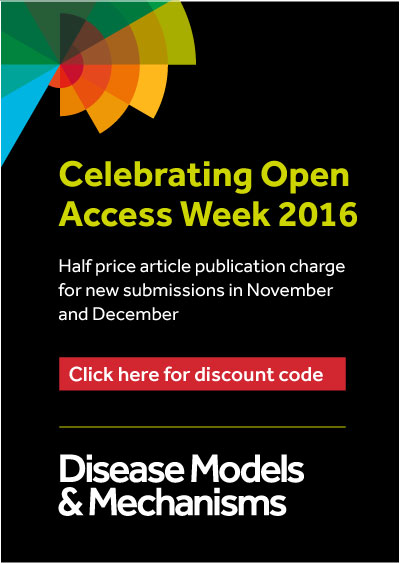Metabolism
A small selection of Open Access articles on metabolism from The Company of Biologists’ journals
METHODS & TECHNIQUES
Development of a diet-induced murine model of diabetes featuring cardinal metabolic and pathophysiological abnormalities of type 2 diabetes
Jodie L. Morris, Tahnee L. Bridson, Md Abdul Alim, Catherine M. Rush, Donna M. Rudd, Brenda L. Govan, Natkunam Ketheesan
Biology Open 2016 5: 1149-1162; doi: 10.1242/bio.016790![]()
Summary: We describe a murine model of type 2 diabetes based on chronic consumption of an energy-dense diet. Longitudinal sampling demonstrates metabolic and pathological changes closely simulating progression to overt diabetes.
RESEARCH ARTICLES
Metabolite profile of a mouse model of Charcot–Marie–Tooth type 2D neuropathy: implications for disease mechanisms and interventions
Preeti Bais, Kirk Beebe, Kathryn H. Morelli, Meagan E. Currie, Sara N. Norberg, Alexei V. Evsikov, Kathy E. Miers, Kevin L. Seburn, Velina Guergueltcheva, Ivo Kremensky, Albena Jordanova, Carol J. Bult, Robert W. Burgess
Biology Open 2016 5: 908-920; doi: 10.1242/bio.019273![]()
Summary: A metabolomics analysis of a mouse model of Charcot–Marie–Tooth type 2D neuropathy revealed a clear distinction between mutant and control samples, and the therapeutic potential of a subset of these changes was explored.
The effects of laboratory housing and spatial enrichment on brain size and metabolic rate in the eastern mosquitofish, Gambusia holbrooki
Mischa P. Turschwell, Craig R. White
Biology Open 2016 5: 205-210; doi: 10.1242/bio.015024![]()
Summary: The discovery of a difference in brain size between adult mosquitofish living in the wild, in spatially enriched tanks and in bare tanks has implications for the effect of environmental enrichment on transferability of data from laboratory animals to their wild counterparts.
To boldly gulp: standard metabolic rate and boldness have context-dependent influences on risk-taking to breathe air in a catfish
David J. McKenzie, Thiago C. Belão, Shaun S. Killen, F. Tadeu Rantin
Journal of Experimental Biology 2015 218: 3762-3770; doi: 10.1242/jeb.122903![]() Highlighted Article: Air is much richer in oxygen than water, but surfacing to gulp air can require boldness in the air-breathing catfish.
Highlighted Article: Air is much richer in oxygen than water, but surfacing to gulp air can require boldness in the air-breathing catfish.
The Menkes and Wilson disease genes counteract in copper toxicosis in Labrador retrievers: a new canine model for copper-metabolism disorders
Hille Fieten, Yadvinder Gill, Alan J. Martin, Mafalda Concilli, Karen Dirksen, Frank G. van Steenbeek, Bart Spee, Ted S. G. A. M. van den Ingh, Ellen C. C. P. Martens, Paola Festa, Giancarlo Chesi, Bart van de Sluis, Roderick H. J. H. Houwen, Adrian L. Watson, Yurii S. Aulchenko, Victoria L. Hodgkinson, Sha Zhu, Michael J. Petris, Roman S. Polishchuk, Peter A. J. Leegwater, Jan Rothuizen
Disease Models & Mechanisms 2016 9: 25-38; doi: 10.1242/dmm.020263![]() Summary: Labrador retrievers with hereditary copper toxicosis are a useful new model for copper-metabolism disorders.
Summary: Labrador retrievers with hereditary copper toxicosis are a useful new model for copper-metabolism disorders.
SHORT COMMUNICATION
Shoaling reduces metabolic rate in a gregarious coral reef fish species
Lauren E. Nadler, Shaun S. Killen, Eva C. McClure, Philip L. Munday, Mark I. McCormick
Journal of Experimental Biology 2016 219: 2802-2805; doi: 10.1242/jeb.139493![]() Highlighted Article: Group living reduces metabolic rate in a shoaling damselfish species, while isolation reduces body condition. Social isolation due to environmental disturbance may therefore have physiological consequences for gregarious species.
Highlighted Article: Group living reduces metabolic rate in a shoaling damselfish species, while isolation reduces body condition. Social isolation due to environmental disturbance may therefore have physiological consequences for gregarious species.
SPECIAL ARTICLE
How informative is the mouse for human gut microbiota research?
Thi Loan Anh Nguyen, Sara Vieira-Silva, Adrian Liston, Jeroen Raes
Disease Models & Mechanisms 2015 8: 1-16; doi: 10.1242/dmm.017400![]()









You must be logged in to post a comment.